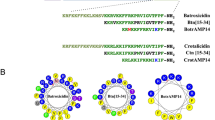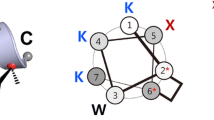Abstract
Polybia-MP1 is a well-known natural antimicrobial peptide isolated from the venom of the social wasp Polybia paulista. A recent study showed that this peptide displays a broad antibacterial spectrum as well as low toxicity to human red blood cells and normal fibroblasts. However, its moderate antimicrobial activity and high susceptibility to protease have been a major hurdle for clinical use. This study examined the possibility of developing biologically more potent, yet metabolically more stable, analogues of MP1 using an emerging technology termed “all-hydrocarbon stapling.” The stapled analogues of MP1 showed more than a threefold increase in helicity as well as an approximately 70-fold enhancement in proteolytic stability. These stapled analogues also exhibited a significant increase in inhibition against some Gram-positive bacteria while displaying a modest enhancement in hemolytic activity. Overall, the current study demonstrated that the all-hydrocarbon stapling system is a highly useful tool for the development of biologically more potent and metabolically more stable analogues of natural antimicrobial peptides.




Similar content being viewed by others
References
Alvares DS, Fanani ML, Ruggiero Neto J, Wilke N (2016) The interfacial properties of the peptide polybia-MP1 and its interaction with DPPC are modulated by lateral electrostatic attractions. Biochim Biophys Acta 1858:393–402
Bhattacharya S, Zhang H, Debnath AK, Cowburn D (2008) Solution structure of a hydrocarbon stapled peptide inhibitor in complex with monomeric C-terminal domain of HIV-1 capsid. J Biol Chem 283:16274–16278
Chen Y-H, Yang J-T, Martinez HM (1972) Determination of the secondary structures of proteins by circular dichroism and optical rotatory dispersion. Biochemistry 11:4120–4131
Dinh TTT, Kim D-H, Lee B-J, Kim Y-W (2014) De novo design and their antimicrobial activity of stapled amphipathic helices of heptapeptides. Bull Korean Chem Soc 35:3632–3636
Dinh TTT, Kim D-H, Nguyen TQ, Lee B-J, Kim Y-W (2015) N-Capping effects of stapled heptapeptides on antimicrobial and hemolytic activities. Bull Korean Chem Soc 36:2511–2515
dos Santos Cabrera MP, Costa ST, de Souza BM, Palma MS, Ruggiero JR, Ruggiero Neto J (2008) Selectivity in the mechanism of action of antimicrobial mastoparan peptide Polybia-MP1. Eur Biophys J 37:879–891
Fox JL (2013) Antimicrobial peptides stage a comeback. Nat Biotechnol 31:379–382
Jenssen H, Hamill P, Hancock REW (2006) Peptide antimicrobial agents. Clin Microbiol Rev 19:491–511
Jorgensen JH, Ferraro MJ (1998) Antimicrobial susceptibility testing: general principles and contemporary practices. Clin Infect Dis 26:973–980
Kim Y-W, Grossmann TN, Verdine GL (2011) Synthesis of all-hydrocarbon stapled [alpha]-helical peptides by ring-closing olefin metathesis. Nat Protoc 26:761–771
Luong HX, Kim D-H, Lee B-J, Kim Y-W (2016) Antimicrobial and hemolytic activity of stapled heptapeptide dimers. Bull Korean Chem Soc 37:1199–1203
Luong HX, Kim D-H, Mai NT, Lee B-J, Kim Y-W (2017) Mono-substitution effects on antimicrobial activity of stapled heptapeptides. Arch Pharm Res 40:713–719
Mahlapuu M, Håkansson J, Ringstad L, Björn C (2016) Antimicrobial peptides: an emerging category of therapeutic agents. Front Cell Infect Microbiol 6:194
Marr AK, Gooderham WJ, Hancock REW (2006) Antibacterial peptides for therapeutic use: obstacles and realistic outlook. Curr Opin Pharmacol 6:468–472
Pham TK, Kim D-H, Lee B-J, Kim Y-W (2013) Truncated and constrained helical analogs of antimicrobial esculentin-2EM. Bioorg Med Chem Lett 23:6717–6720
Phillips C, Roberts LR, Schade M, Bazin R, Bent A, Davies NL, Moore R, Pannifer AD, Pickford AR, Prior SH, Read CM, Scott A, Brown DG, Xu B, Irving SL (2011) Design and structure of stapled peptides binding to estrogen receptors. J Am Chem Soc 133:9696–9699
Schafmeister CE, Po J, Verdine GL (2000) An all-hydrocarbon cross-linking system for enhancing the helicity and metabolic stability of peptides. J Am Chem Soc 122:5891–5892
Souza BM, Mendes MA, Santos LD, Marques MR, César LM, Almeida RN, Pagnocca FC, Konno K, Palma MS (2005) Structural and functional characterization of two novel peptide toxins isolated from the venom of the social wasp Polybia paulista. Peptides 26:2157–2164
Tossi A, Sandri L, Giangaspero A (2000) Amphipathic, α-helical antimicrobial peptides. Biopolymers 55:4–530
Tyndall JDA, Nall T, Fairlie DP (2005) Proteases universally recognize beta strands in their active sites. Chem Rev 105:973–1000
Verdine GL, Hilinski GJ (2012) Stapled peptides for intracellular drug targets. Methods Enzymol 503:3–33
Won H-S, Kang S-J, Choi WS, Lee B-J (2011) Activity optimization of an undecapeptide analogue derived from a frog-skin antimicrobial peptide. Mol Cells 31:49–54
Yeaman MR, Yount NY (2003) Mechanisms of antimicrobial peptide action and resistance. Pharmacol Res 55:27–55
Zasloff M (2002) Antimicrobial peptides of multicellular organisms. Nature 415:389–395
Zhang H, Zhao Q, Bhattacharya S, Waheed AA, Tong X, Hong A, Heck S, Curreli F, Goger M, Cowburn D, Freed EO, Debnath AK (2008) A cell-penetrating helical peptide as a potential HIV-1 inhibitor. J Mol Biol 278:565–580
Zhao Y, Zhang M, Qiu S, Wang J, Peng J, Zhao P, Zhu R, Wang H, Li Y, Wang K, Yan W, Wang R (2016) Antimicrobial activity and stability of the D-amino acid substituted derivatives of antimicrobial peptide Polybia-MP1. AMB Express 6:122
Acknowledgement
This work was supported by the National Research Foundation of Korea (NRF) grant funded by the Korea government (MSIT) (2015R1D1A1A01060265).
Author information
Authors and Affiliations
Corresponding author
Ethics declarations
Conflict of interest
The authors declare no conflict of interest.
Rights and permissions
About this article
Cite this article
Luong, H.X., Kim, DH., Lee, BJ. et al. Antimicrobial activity and stability of stapled helices of polybia-MP1. Arch. Pharm. Res. 40, 1414–1419 (2017). https://doi.org/10.1007/s12272-017-0963-5
Received:
Accepted:
Published:
Issue Date:
DOI: https://doi.org/10.1007/s12272-017-0963-5




